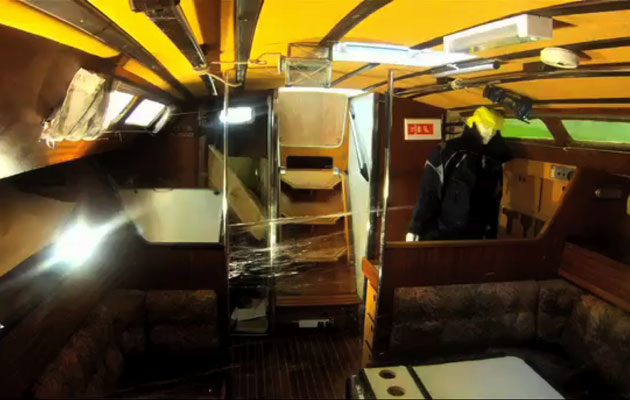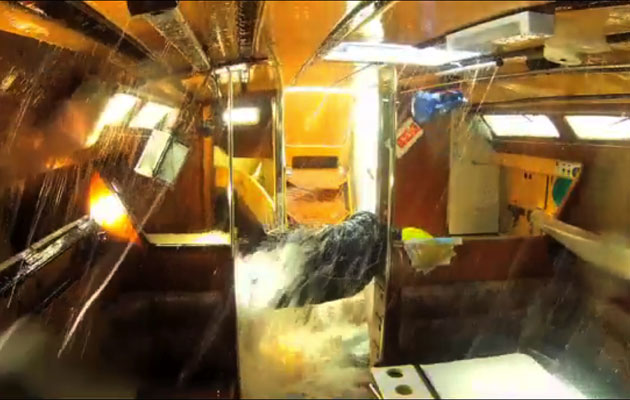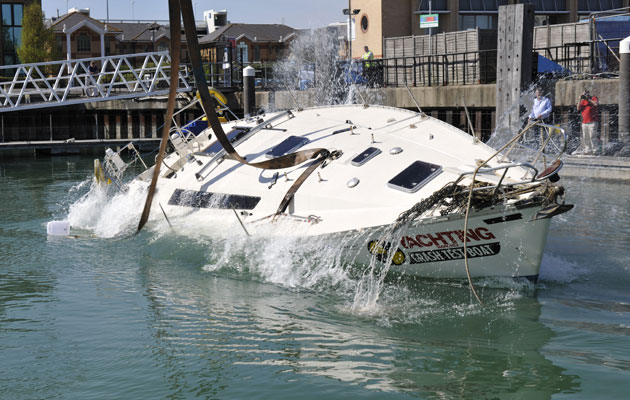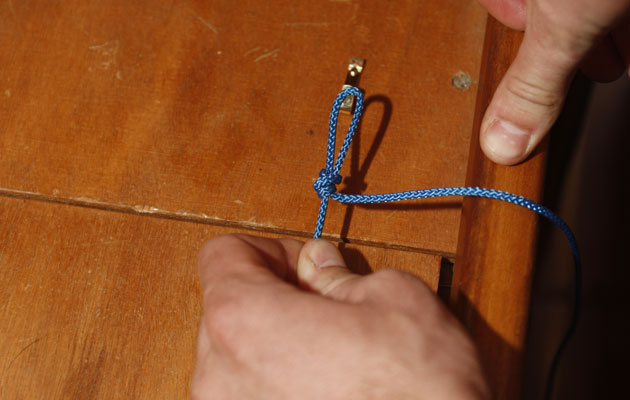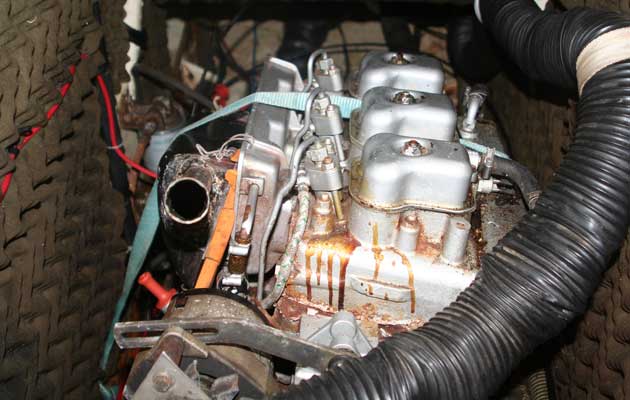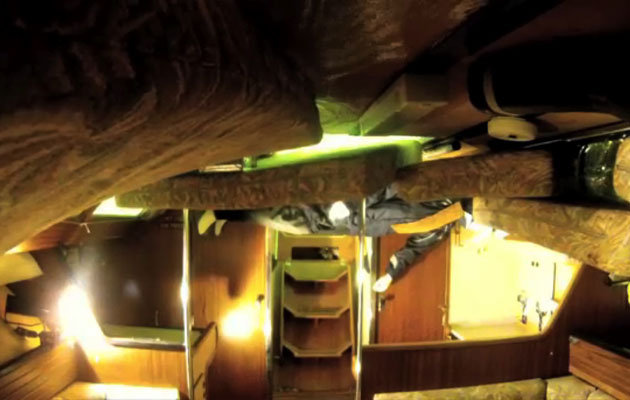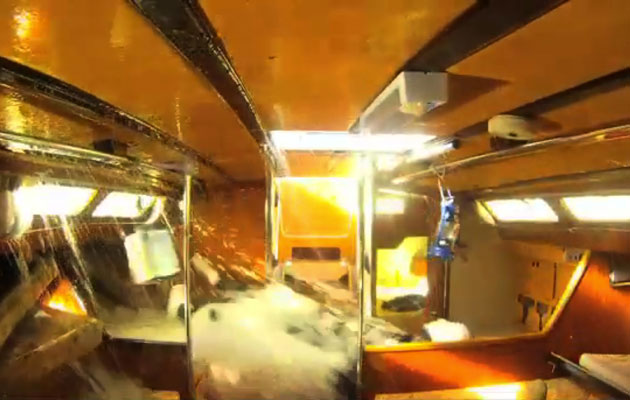What really happens during a capsize? How can we make the saloon safer? Chris Beeson and the Crash Test Boat crew recreate a capsize with chilling results
Crash Test Boat – Capsize
‘Safety is not a yellow box with a set of batteries and a panic button. And it’s certainly not relying on the Coastguard. Safety is thinking about the problems you might encounter and ensuring you’ve considered your options.’
So said sailing journalist Matt Sheahan in our August 2009 issue, writing about the 1979 Fastnet Race. Matt survived the race but his father David, skipper of their Nicholson half-tonner Grimalkin, died with fellow crew member Gerry Winks. Matt’s words also neatly encapsulate the thinking behind our new Crash Test Boat series.
‘Lethal missiles’
Of the 303 yachts that started the ’79 Fastnet, 112 reported knockdowns, 77 of which were B2 knockdowns, ones in which the mast is substantially below horizontal, the yacht inverts or undergoes a full 360-degree roll. The inquiry into the disaster reported: ‘In several boats, cookers and batteries fell out of their mountings. Both items are potentially lethal missiles.’
On his Fastnet ’79 experience, Matt added: ‘Dangers below are frequently ignored. One of the biggest problems aboard Grimalkin during the height of the storm was how objects broke loose. Each time the yacht suffered a knockdown, tins of food and other heavy objects were flying around the saloon. When Grimalkin was recovered, one of the lead acid batteries, which had been secured under the companionway steps, was found wedged in the yacht’s bow. This deadly missile had taken away part of the main bulkhead during one of our pitchpoles.’
Seeking refuge
Twenty-four yachts were abandoned, even though all but five were recovered afloat. Conditions on board were so unbearable that, in Force 11 winds and mountainous seas, several skippers decided to abandon several tons of solid boat for a hundred pounds of rubber.
Having abandoned, seven competitors were subsequently lost from liferafts. How could such a counter-intuitive decision have been made?
The 1979 Fastnet Race Inquiry recommended that ‘The Memorandum on Safety should draw attention to the need for the securing arrangements for heavy items of equipment and all stowages to be effective in the event of a total inversion.’ With that in mind, we wanted to find out how catastrophic the effects of capsize are and how we can make our boats more secure – more survivable – in a capsize without redesigning the interior or spending huge sums of money.
Our test involved two separate 360° rollovers. In one we secured as much as we could down below, including the galley stove, lockers, chart table, cabin sole, etc. The second test showed the devastation caused in an unsecured yacht, with no modifications made to counter the effects of loose items flying around. See below for details on batteries, engine and fuel and water tanks.
What happens in a capsize?
Since I couldn’t be onboard (no-one’s insurance company would even begin to think about it) we needed some other way of finding out what happens when a boat capsizes. Luckily Yachting TV’s Steve Adams agreed to help us out by strategically-positioning two waterproof HD cameras below. He also fitted lights. With no domestic power and the boat upside-down, there would be very little light in the saloon and we needed to capture the action clearly. The results are frightening.
Crash Test Boat crew
To illustrate what would happen to crew down below during a capsize, we bought three mannequins, named Tom, Dick and Harry, and stood one in the galley, laid another in a pilot berth and a third in the forepeak, supposedly out of harm’s way.
Unsecured roll: just as she is
Having taken up the slack and extended the crane’s boom to haul the Crash Boat 30ft clear of the pontoon, and with two Crash Boat crew loosely holding onto the bow and stern lines, the crane began to lift. Soon crashes could be heard from inside the boat.
Once she reached her angle of vanishing stability, around 130°, gravity took over and she rolled over onto her deck. Unnervingly but not unsurprisingly, she was extremely stable upside-down and would never have righted without the crane. After a few seconds’ completely inverted, the lift resumed. With the keel 40-45° below vertical, gravity took over again and the keel plunged into the water, sending a mini-tidal wave across the dock.
On the foredeck, the anchor had stayed put, tied into the bow roller, but the chain had broken out of the anchor locker. Fortunately, only a couple of feet dangled over the side because the taut chain between the anchor and the windlass had blocked the bulk of it escaping.
Inside: total carnage
Once below I saw that my stand-in, Harry, the forepeak mannequin, had broken at the waist, had an arm sheared off and was buried in cushions.
I was shocked by the violence of the capsize in such a small, safe cabin. It was also obvious that an amazing amount of water had flooded into the boat too, something the video later confirmed. It was still dripping off the headlining, which was soaked throughout. The obvious inlets were the two vents just forward of the mast and the gaps between the hatch, washboards and the companionway, but there could have been others.
In the saloon, Dick’s lee strap had held him in place but his repose was completely at odds with the devastation surrounding him. The heavy marine ply sole boards had broken free, a small board had lodged under a saloon hand-hold. The starboard leaf had been torn from the saloon table, presumably by the passing sole board. Bilge water was above sole level and debris of every kind floated in it or sank beneath it.
Cutlery and spares drawers, though still closed, were full of water. Everything was everywhere, the contents of the stove and coolbox were strewn around the saloon and the aft heads – both toilets were full – papier maché charts decorated the galley and the stove had escaped its mounts but thankfully not its well.
Stepping carefully around the carnage, I noticed that there was a steady stream of water running from the engine bay into the heads. A minute later the stream was just as bad. Were we sinking? Though stunned by the wreckage of what, a moment ago, was a tidy boat, the thought that we would founder in the marina focused the mind. Clearly we hadn’t hit anything but had the lifting strop damaged the stern tube? Was the rudder stock damaged when the blade hit the water? It was coming from somewhere.
Using a plastic bowl found wedged under the galley trim, a boot and a glass, three of us started bailing water into the galley sinks – the cockpit drain was blocked – while a fourth person looked for the source of the leak.
After checking the steering quadrant and finding nothing wrong, we lifted the companionway steps and pointed a torch into the black space behind the engine. There it was, a steady stream of water, thankfully not coming from the stern tube.
Leaving three bailing, I checked the starboard aft cockpit locker and found it full of water, scooped up during the capsize. Without padlocks, the hasps had just fallen open. The violence of the righting had torn one of the three hinges free and water was now draining from the locker into the engine bay. After struggling to comprehend that the boat’s watertightness was so fundamentally undermined, the general sensation was relief. Later, looking at the 1979 Fastnet Race Inquiry, it revealed that 46 of the skippers, 20 per cent of the inquiry’s respondents, reported the cockpit lockers were ‘a significant water entry point’.
How can we make a boat safer? Let’s look at a few simple adjustments we made with basic tools to demonstrate what happens when a secure boat suffers a capsize.
Basic modifications: how you can make your boat safer
The Crash Test Boat has finger-operated levers as locker latches throughout. We decided these were independent of gravity and secure enough not to warrant any modification. We thought something might knock the lever from inside the locker but, as no one was onboard, it would be a revealing exercise.
The crockery was stored in T-slots and these clearly were not gravity-proof. We ran a line through some netting, tied loops in each end and hooked them on to picture hooks nailed into the Formica. Again this was a pretty poor effort aesthetically but it was a quick, cheap solution, but would it be effective?
The Crash Test Boat’s stove has a hinged cover so all we needed to do was fit a sliding bolt latch to it. We thought this, combined with the stove grabrail, should contain the stove when it fell out of its mounts. Without a cover, brackets screwed into the stove well, just above the gimbals, should keep it in place. The coolbox lid removed completely so we fastened that with string looped over two screws, another hasty but hopefully effective solution.
Cabin Sole
Although the sole was not screwed down, there were countersunk holes in each board so clearly they had been secured at some stage. All we had to do was screw them down again. It’s neither an elegant nor a particularly convenient way to secure the boards – fitting them with finger-operated latches would be much better. Another possible solution that emerged was to fit eyebolts beneath each board and run a line through them, secured in the engine bay perhaps. I’m sure you can think of others.
Under seat stowage
Stowage below the saloon seating was secured using the simple screw-and-string method pioneered on the coolbox lid. It’s quick, cheap and, as it’s covered by cushions, its inelegance didn’t matter.
Chart table
Home to dividers, batteries, mobile phones, batteries, spectacles, and more, the chart table had to stay shut. We used a sliding bolt latch again. We should have placed netting across the bookshelf too and secured the locker beneath the navigator’s feet.
Systems
Engine
As the engine did not have captive bolts, we had to secure it in place with a ratchet strap to ensure it didn’t leave its mounts. Our capsize had to result in zero pollution so the engine oil was drained and the dipstick/oil filler and crankcase breather sealed. After that, all we needed to do was to clean up the mixture of oil, diesel and water sloshing around in the engine bay.
Batteries
The Crash Boat has three batteries, two big domestic batteries and a smaller cranking battery. All were securely strapped but only the latter was sealed so to ensure zero pollution, we removed the domestic batteries. Both were on the pontoon so we could run the bilge pump when needed.
Tankage
The Crash Boat’s stainless steel tanks were all laminated into place so, other than emptying them, no preparation was needed. We couldn’t find a way of getting to the bottom of the fuel tank so, to drain it, we removed the sender, pumped out the tank, replaced the sender then taped a plug into the fuel tank breather to make sure nothing escaped.
Secure roll: after the modifications
On deck, we left the anchor tied in place but tied a rope strop from toerail to toerail across the anchor locker to make sure the chain didn’t break out. We also padlocked the cockpit lockers. Then we followed the same process as we did in the unsecured roll.
After the capsize, I noticed the anchor locker was still shut and the anchor securely tied into the bow roller. So far, so good. Entering through the forward hatch, the first thing I sensed, rather than saw, was general disorder in contrast to the chaos on the unsecured roll.
Inside: disorder
In the saloon I noticed that Dick, without his lee strap, had been flung from his port pilot berth, across the saloon table and was now lying face down on the cabin sole to starboard. Tom had broken a leg and was lying on the sole at the base of the companionway perusing a soggy Reed’s almanac. Unfortunately he’d kicked the camera above the chart table during the roll so we lost its view of the second half of the first roll. The shattered remains of one or two plates, strewn over the chart table and starboard seating, confirmed that the crockery net hadn’t been a complete success.
The sole boards were not awash but there was clearly a lot of water in the boat. The contents of the saloon seating lockers – the toolbag, flares and the file containing the ship’s papers – were submerged. The chart table’s bin lockers and shelves were brimful too.
Only one galley locker had opened from which a plastic spoon escaped and wedged itself under a hand-hold. The saloon cushions had assembled themselves neatly in the starboard pilotberth but apart from that, she seemed in fairly good shape for a boat that had just gone through what she had.
What we learned
Even in these benign, controlled conditions, after two gentle 360° rolls, the chaos that reigned below was horrifying. It gave a harrowing glimpse of the terror that the crews must have felt in the early hours of Tuesday, 14 August, 1979 in the Western Approaches.

Unsecured: Sole boards, table leaves, charts, chargers, flares and cans littered the saloon. Complete disorder
With repeated rolls and so many loose items in the saloon, life itself was no more than a game of Russian roulette. Indeed, of the 44 yachts that issued distress signals, over half did so because of ‘concern for the general safety of the crew’. It’s easy to be critical of those who abandoned boats that were later recovered afloat, but for someone who wasn’t there, it’s impossible even to imagine the living hell that their yachts had become.

Unsecured: Only the gas pipe held the stove in place, all else is destroyed, dislodged or disgorged. Terrifying
In terms of what we learned, the state of the saloon after the unsecured roll confirmed that the simple, inexpensive measures we installed over the course of a couple of days with the most basic tools had, almost without exception, worked perfectly.
Secured by a lee cloth, you would have nothing more threatening than a cushion to deal with. The amount of flooding would be extremely alarming but with bilges free of detritus you would be better able to deal with it.
How to avoid capsize
1 It can happen In Adlard Coles’ Heavy Weather Sailing, tank testing revealed that any yacht will capsize when hit beam-on by a wave taller than 55 per cent of the yacht’s LOA. Today’s lighter, beamier yachts are more prone to capsize and the figure is more like 40 per cent. Safety in extreme sea conditions has been compromised for speed and manoeuvrability, and comfort and space below. It’s a compromise well worth the taking – provided you follow certain rules.
2 Gather forecasts In 1979, forecasting was an even more inexact science than it is today so none of the competitors would have had any idea what awaited them until it was unavoidable. Nor was the fitting of a VHF radio compulsory. A few with Long-Wave sets picked up broadcasts by Radio 4 and Meteo France but again, not until a few hours before the storm struck.
Today forecasting has much greater accuracy and sources are abundant, on radio, online, via NavTex, GRIBs. ‘I couldn’t get a forecast’ is no longer an excuse for finding yourself in challenging conditions. If you feel the conditions will take you outside your comfort or competency, stay alongside and spend the day doing something else.
3 Storm tactics Yachts are most vulnerable to capsize when beam-on to large waves so a correctly deployed sea anchor will ensure your safety. In sailing terms, tactics employed during the 1998 Sydney-Hobart Race demonstrated that extreme seas are best taken head-on with your best helmsman. Running with storm jib or trysail, close reach across the troughs, head up into the crests then bear away sharply at the top to avoid slamming on the back of the wave.
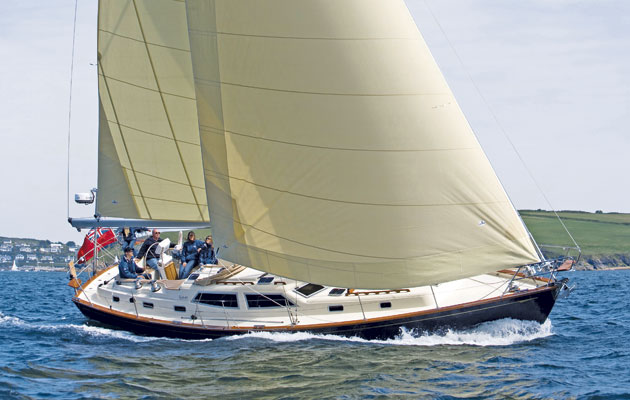
If your sailing plans can’t avoid storms, make sure your boat is up to the job, like this Rustler 44
4 Right tools for the job If you are planning to cruise higher latitudes, get the right boat. Forecasting and seasonal trends can help you avoid bad weather, you could be exposed on longer passages. Choose a boat with a STIX number greater than her LOA, a ballast ratio of 40 or above and a length/displacement ratio of at least 250.
‘So how do we capsize a boat?’
We had considered fitting a remote control autopilot and sending her across overfalls in a strong breeze with wind-over-tide, but not for long. The chance of losing her was too high and we wouldn’t be able to conduct two controlled, identical rolls. It had to be a crane. Unfortunately, this also meant that at least half of the roll would be very sedate, nothing like the horror of the Fastnet 1979, but the exercise still seemed valid in terms of the lessons we could learn.
Wanted: capsize expert
Very few people have experience of how to deliberately capsize a yacht – it’s not a skill for which there’s much call – but there was one among the friends of Yachting Monthly who did: Mike Golding. One of the safety checks required by IMOCA, the body that governs the IMOCA 60s that race around the world in the Vendée Globe and Barcelona World Race, is self-righting from an inverted position using the IMOCA 60’s canting keel.
To roll her, we needed attachments for the two massive crane strops and the solution, though flimsy-looking, received Mike’s backing and held remarkably well. Using four shackles, 2x5m of 8mm Dyneema and two short lengths of Spectra, we made two lashings between the main and mizzen masts’ chainplates to which the crane’s nylon lifting strops attached. Since we weren’t actually lifting the boat, it was thought that this should be man enough for the job but, as with every other aspect of this test, nobody really knew what would happen.
Mike is a very busy man so we were hugely appreciative when he agreed to spend a morning with us looking at our plans, highlighting the defects in it and suggesting improvements. He was also there on the day to advise on improvements to the set-up and instruct the crane driver. Hats off to you, Mike.
MDL provides the location
We spoke to MDL and they kindly agreed to make Ocean Village, where Mike tests his yachts, available for the capsize, provided there was zero pollution. In our first meeting, Mike told us we would need to empty its oil and seal the engine, likewise the fuel tank, and remove anything that didn’t float. He also recommended that we check whether the engine had captive bolts. Without them, the engine could leave its mountings and tear out the stern tube, or drop through the cockpit and into the marina. It would need to be secured in place somehow.
Osmotech gets her ready
Next we asked Mike Ingram from Osmotech to visit the boat. I explained our plan to him and asked him how we could prepare her. He said the engine mountings were definitely not up to it and he sent down one of his crew to drill two holes in the engine bay’s plywood and run a
webbing ratchet strap across the top of the engine.
He didn’t like the look of the two-part washboards either. First, it had a large vent in it and second, it was considered too ill-fitting to fulfil its function. Since our aim was not to sink the boat – the strop attachments we had would not have enabled the crane to lift her off the bottom – Osmotech made a one-piece marine ply washboard fitted with a handle and two bolts to secure it in place.
Above deck
Hamble rigger Alan Moore unstepped the masts because they would have broken during capsize and we want to break them later, in a separate test. We also removed the granny bars and the lifelines because the crane’s lifting strops would have torn out those and the stanchions.
For the secure roll we added padlocks to the cockpit locker hasps, tied the anchor to the bow roller and secured a strop over the anchor locker to contain the chain. The strop was removed for the unsecured roll but the anchor remained tied. With no strop we fully expected to be hauling 30m of chain off the bottom of Ocean Village and we didn’t want an anchor on the end of it. For both rolls, the lockers were emptied of everything that wouldn’t float.
Other tests in the Crash Test Boat series









